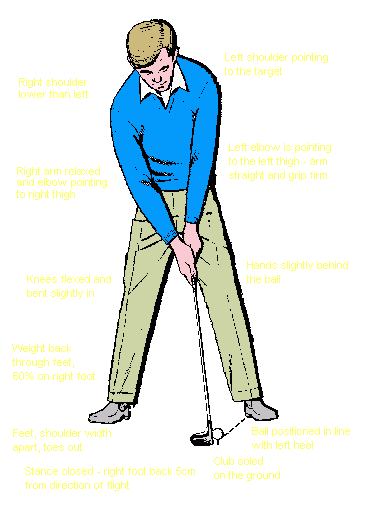
Home >> The Hands >> The Stance >> Teeing the Ball >> The Address
Assume the stance and ground the club behind the ball, you are now considered at 'address'.
Place the hands on the club in a firm overlapping grip. This grip is an extension of the shaft at the address and does not change or loosen from the time the club leaves the ball on the backswing until the finish of the follow-through.
The preparatory steps have now been taken in the building of a swing.

Sole the club on the ground behind the ball, let the arms hang comfortably, making sure they are not bent at the elbows - extended but not stiff. The reason for having the arms extended is to get the radius of the swing established. The radius is kept throughout the swing by keeping the left arm extended until the ball has been hit.
In addressing with the driver, the hands are just slightly behind the ball. in addressing fairway woods and iron shots, the hands are slightly ahead of the ball and the shaft is slanting backward to where the clubhead is soled behind the ball.
The length of the shaft will determine how far from the ball you should be standing. The left elbow is pointing to the left thigh and the right elbow pointing to the right thigh . In reaching lower with the right hand to grip the club, the right shoulder moves down and slightly forward. This movement of the right shoulder subconsciously makes you 'open' your body to the ball, makes you aim to the left, restricts your backswing and shoulder turn, and causes you to slice the ball with an outside-in movement. To correct this and to line-up towards the target or parallel to the line of flight the shoulders should be squared around so that you think he is looking at the target over the point of your left shoulder. This is correct and serves as a check point for direction.
The bridge between the address and the actual start of the backswing is 'the waggle'. As you take up your stance, look at the target and work out what type of shot you are going to play, you waggle the club back and forth for the definite purpose of getting his muscles relaxed and to giving a "running start" on your backswing so that you do not start from a frozen position. The "waggle" is in miniature the hand action of the swing and most players swing as they waggle. If the player has a fast, jerky waggle, he will have a fast and jerky swing. This preliminary action applies to most ball sports and in cricket, tennis or squash you will see the good player constantly moving his bat or racquet to keep his muscles loose for instant and accurate response.
By improving the waggle you improve the swing, as for all general purposes the backswing is simply an extension of the waggle and the club follows the same path and is swung back at the speed that this preliminary movement has regulated.
Some years back golfers were taught that the backswing was initiated by the 'forward press'. This action was a forward movement of the hand, club and weight of the body and on recoil the backswing started. Its great fault was that the beginner over exaggerated the movement, did not transfer his weight back and tried to swing and hit the ball with his weight on the left foot.
In the waggle, the left hand is the controlling hand. The right works along with the left. The shoulders, the hips or the body weight do not turn, move or shift.
The upper part of the arms remains against the sides of the chest. The wrists break so that the head of the club goes straight back along the ground, about eighteen inches to two feet behind the ball.
Make sure the wrists are broken (not rolled) so that the face of the club does not open but goes straight back from the ball. Each time the club is waggled back, the right elbow brushes the front part of the right hip
Throughout we have placed special emphasis on the fact that a golf swing is built step by step. As each step performs it lays a foundation for the next step, to which it is connected. The golfer must clearly understand the inter-relationship of clubs, feet, hands, arms, shoulders and hips to play good golf.